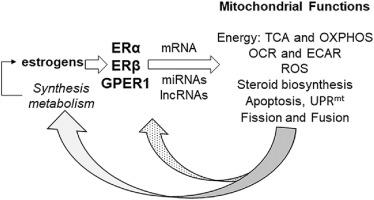Redox Biology ( IF 10.7 ) Pub Date : 2020-01-23 , DOI: 10.1016/j.redox.2020.101435 Carolyn M Klinge 1

|
Sex-based differences in human disease are caused in part by the levels of endogenous sex steroid hormones which regulate mitochondrial metabolism. This review updates a previous review on how estrogens regulate metabolism and mitochondrial function that was published in 2017. Estrogens are produced by ovaries and adrenals, and in lesser amounts by adipose, breast stromal, and brain tissues. At the cellular level, the mechanisms by which estrogens regulate diverse cellular functions including reproduction and behavior is by binding to estrogen receptors α, β (ERα and ERβ) and G-protein coupled ER (GPER1). ERα and ERβ are transcription factors that bind genomic and mitochondrial DNA to regulate gene transcription. A small proportion of ERα and ERβ interact with plasma membrane-associated signaling proteins to activate intracellular signaling cascades that ultimately alter transcriptional responses, including mitochondrial morphology and function. Although the mechanisms and targets by which estrogens act directly and indirectly to regulate mitochondrial function are not fully elucidated, it is clear that estradiol regulates mitochondrial metabolism and morphology via nuclear and mitochondrial-mediated events, including stimulation of nuclear respiratory factor-1 (NRF-1) transcription that will be reviewed here. NRF-1 is a transcription factor that interacts with coactivators including peroxisome proliferator-activated receptor gamma, coactivator 1 alpha (PGC-1α) to regulate nuclear-encoded mitochondrial genes. One NRF-1 target is TFAM that binds mtDNA to regulate its transcription. Nuclear-encoded miRNA and lncRNA regulate mtDNA-encoded and nuclear-encoded transcripts that regulate mitochondrial function, thus acting as anterograde signals. Other estrogen-regulated mitochondrial activities including bioenergetics, oxygen consumption rate (OCR), and extracellular acidification (ECAR), are reviewed.
中文翻译:

雌激素控制线粒体功能。
人类疾病中基于性别的差异部分是由调节线粒体代谢的内源性类固醇激素水平引起的。这篇综述更新了 2017 年发表的关于雌激素如何调节新陈代谢和线粒体功能的综述。雌激素由卵巢和肾上腺产生,脂肪、乳腺基质和脑组织产生少量雌激素。在细胞水平上,雌激素调节多种细胞功能(包括生殖和行为)的机制是通过与雌激素受体 α、β(ERα 和 ERβ)和 G 蛋白偶联 ER (GPER1) 结合。ERα 和 ERβ 是结合基因组和线粒体 DNA 来调节基因转录的转录因子。一小部分 ERα 和 ERβ 与质膜相关信号蛋白相互作用,激活细胞内信号级联,最终改变转录反应,包括线粒体形态和功能。尽管雌激素直接和间接调节线粒体功能的机制和靶标尚未完全阐明,但很明显雌二醇通过核和线粒体介导的事件调节线粒体代谢和形态,包括刺激核呼吸因子-1(NRF- 1) 将在此处审查的转录。NRF-1 是一种转录因子,可与共激活因子(包括过氧化物酶体增殖物激活受体 γ、共激活因子 1 α (PGC-1α))相互作用,调节核编码的线粒体基因。NRF-1 的靶点之一是 TFAM,它结合 mtDNA 来调节其转录。核编码的 miRNA 和 lncRNA 调节 mtDNA 编码和核编码的转录本,从而调节线粒体功能,从而充当顺行信号。其他雌激素调节的线粒体活动包括生物能学、耗氧率 (OCR) 和细胞外酸化 (ECAR)。











































 京公网安备 11010802027423号
京公网安备 11010802027423号